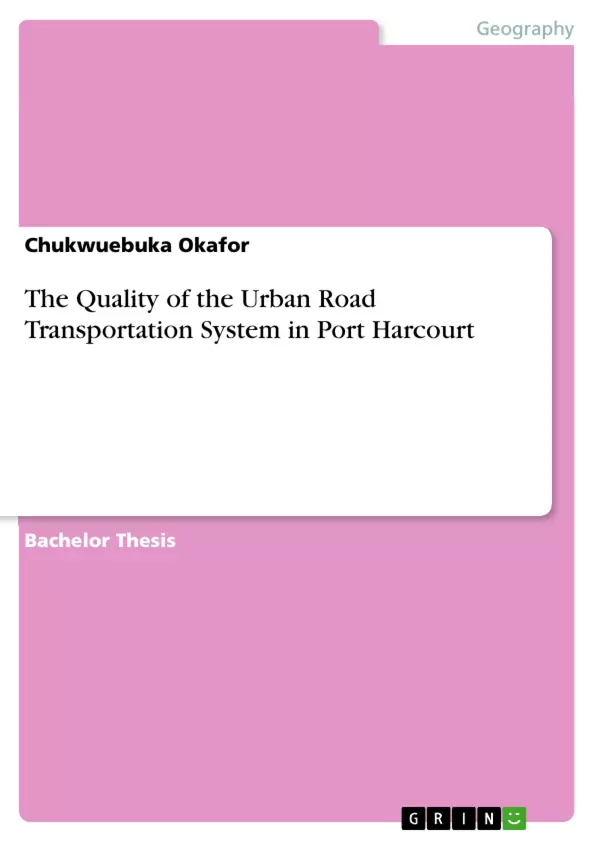This research work critically assesses the quality of urban road transportation system in Port Harcourt Metropolis. It does so by defining transportation as the means of conveying, conveyance or been conveyed from one place to another and it involves humans, animals and objects. It also addresses all necessary infrastructures that must be functional to make the transport system in the study area efficient. Excessive traffic demand is choking the study area even when car ownership is moderate due to poor city structure and narrow roads. Further, increased traffic demand is expected in the study area by the year 2030. The study in achieving its goal employed the mixed method design and the case study method, whereby both qualitative and quantitative research components were used in the data analysis and the central point of the findings is that the quality of road transport service in the study area is declining despite the recent development in the transportation sector. Hence, this study, advocates for more relevant and vital transportation infrastructures that will aid the efficiency of urban road transport services in Port Harcourt Metropolis and also the culture of maintenance should be inculcated to ensure its durability. The study concludes that quality of urban road transportation system in Port Harcourt Metropolis City will increase to a very high level and will in turn increase the economic state of the city if all relevant transport infrastructures and policies are put in place both by the state and federal government in Nigeria.
Inhaltsverzeichnis (Table of Contents)
- CHAPTER ONE: INTRODUCTION.
- 1.1. BACKGROUND TO THE STUDY
- 1.2. STATEMENT OF THE PROBLEM
- 1.3. AIM AND OBJECTIVES OF THE STUDY
- 1.3.1. AIM OF THE STUDY.
- 1.3.2. OBJECTIVES OF THE STUDY
- 1.4. RESEARCH QUESTIONS...
- 1.5. SIGNIFICANCE OF THE STUDY.
- 1.6. SCOPE OF THE STUDY
- 1.6.1. Geographical Scope
- 1.6.2. Context...
- 1.7. STUDY AREA
- 1.7.1 Location and Size..
- 1.8. LIMITATION OF STUDY.
- CHAPTER TWO: THEORETICAL, CONCEPTUAL AND LITERATURE REVIEW.
- 2.1. THEORETICAL FRAMEWORK
- 2.1.1. Multiple Nuclei Model ......
Zielsetzung und Themenschwerpunkte (Objectives and Key Themes)
This research project examines the quality of urban road transportation in Port Harcourt Metropolis, Nigeria. It aims to understand the challenges faced by the transportation system and to identify potential solutions to improve its efficiency and effectiveness.
- Assessment of the current state of urban road transportation in Port Harcourt Metropolis
- Analysis of the factors contributing to the quality of the transportation system
- Identification of key challenges and bottlenecks affecting the efficiency of the system
- Evaluation of potential solutions to address the identified challenges
- Recommendations for improvement of urban road transportation in the study area
Zusammenfassung der Kapitel (Chapter Summaries)
Chapter one provides a comprehensive introduction to the study, outlining the research problem, objectives, significance, and scope. It also delves into the study area, its location, and the limitations of the research.
Chapter two explores the theoretical and conceptual framework for the study, drawing upon existing literature and research in the field of urban transportation. It particularly focuses on the multiple nuclei model and its application to the study area.
Schlüsselwörter (Keywords)
Urban road transportation, Port Harcourt Metropolis, Nigeria, transportation infrastructure, traffic congestion, urban planning, transportation efficiency, transportation policy.
- Quote paper
- Chukwuebuka Okafor (Author), 2021, The Quality of the Urban Road Transportation System in Port Harcourt, Munich, GRIN Verlag, https://www.grin.com/document/1289722



